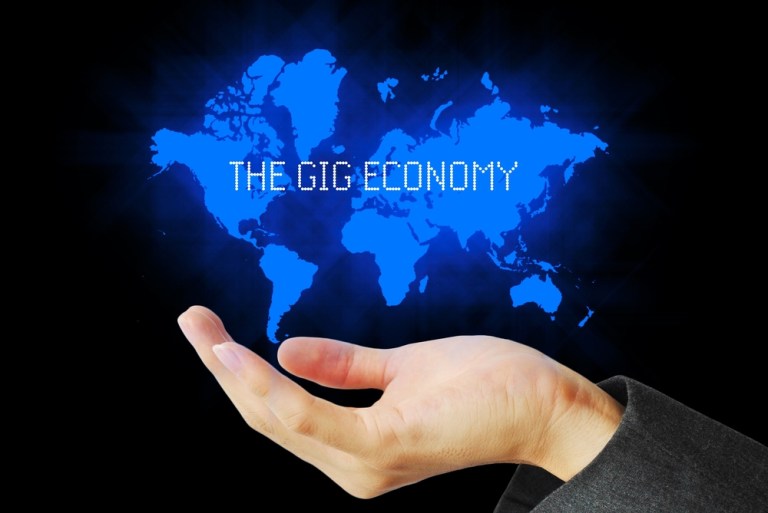The Gig Economy’s Great 2016

With more employees, employers and cash entering the gig economy and legislation protecting gig workers passing in NYC, 2016 was a good year to gig. Will 2017 be the same?
2016 was a good year for the gig economy, full of growth and new protections. But with plenty of economic and political uncertainty looming in 2017, what will come of this burgeoning new sector of the economy?
According to new statistics from the McKinsey Global Institute, as much as one-third of workers in the current economy are engaged in this kind of short-term, ad-hoc work. What’s more, the vast majority of both full-time and part-time workers take these jobs out of choice, because they enjoy the benefits the new gig economy offers, rather than out of necessity or lack of other job opportunities.
And, as the inaugural edition of the PYMNTS.com Gig Economy Index indicated, there are plenty of reasons workers are choosing freelancing and gig employment over a traditional job. Index research reported that 31 percent of gig employees can support themselves through one gig. And payment arrives quickly, with 70 percent of gig workers receiving payment within one week. Workers also largely don’t have to pay fees on the income they do make from any gigs or freelance jobs.
There are also plenty of lifestyle benefits to working in the gig economy, with nearly 40 percent of gig workers saying that they choose gigs because they enjoy the flexibility it provides to their schedule and the freedom it provides to spend time with family or embrace a passion or hobby.
Perhaps it’s no surprise that Breanden Beneschott, cofounder and COO of Toptal, which offers freelance software engineers and designers to companies in need of on-demand talent, told PYMNTS that he expected the gig economy to grow even larger in the months and years to come.
“A lot of really great people are increasingly looking for flexibility in their work, and a lot of them are finding it via the gig economy,” he said. “I see that happening more and more every single day with our clients and within the whole ecosystem, from startups to large companies, and I don’t see that changing.”
Giving gig employees protections
Even with so many American workers entering this new sector of the workforce, there are still plenty of unanswered questions about what it means to be a gig worker.
Most cities or states do not have laws specifically protecting short-term employees or providing them with recourse if they are mistreated or not paid, according to Caitlin Pearce, director of member engagement for the Freelancers Union.
But, as PYMNTS reported, one city did take a step forward in passing protections for these employees, as the world’s business capital, New York City, unanimously passed legislation introduced to the City Council by Council Member Brad Lander that would extend a social safety net and provide gig workers with new wage theft protections.
The legislation, described as a “first-of-its-kind” bill, is designed for gig employees and freelancers, who often work short, ad-hoc jobs for various companies.
Pearce told PYMNTS she was “thrilled” to see the protections pass, noting that gig employees, which make up nearly 40 percent of the city’s workforce, have been working to secure rights like these for a long time.
“It’s something we’ve heard about time and time again from our members. There is very little recourse for someone who is freelancing and isn’t being treated fairly,” she said.
She also noted that she hopes the legislation could become an example for the rest of the country.
“We really see New York City as being the first of many cities or even states that could model their legislation based on the economic situation in their area,” she said.
Gig workers take control
While legislators and advocates are working to help protect gig workers, new research indicates that their value to companies and employers is already on the rise.
According to a study from top search firm Korn Ferry, employers can no longer think of contingent workers as interchangeable and disposable. That’s the top projection of the annual Trends Predictions for 2017.
Jeanne MacDonald, global operating executive and president of talent acquisition solutions for Korn Ferry Futurestep, noted that employers should expect to start offering the same pay and benefits to gig employees and full-time workers.
“Don’t expect to pay contingent workers less than full-time employees,” she said. “While their hourly or contract rates are often more than salaried employees, employers are paying for a unique skill that only a few select people can bring to the table.”
2017 looks like it will surely be a big year for the gig economy. For the latest insight and news in the sharing economy, keep your eyes on PYMNTS.com and the PYMNTS.com Gig Economy Index.
TO DOWNLOAD THE Q3 2016 GIG ECONOMY INDEX, FILL OUT THE FORM BELOW:
About The Index
The PYMNTS.com Gig Economy Index™, a Hyperwallet collaboration, is designed to better understand workers in the gig economy — people who often work in short-term, ad hoc positions — who they are, what services they supply and what percentage of their overall income the gigs represent.